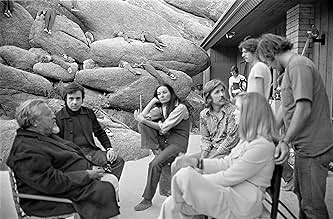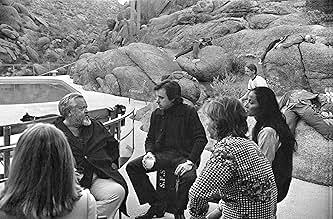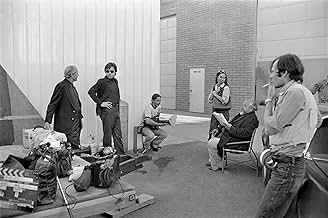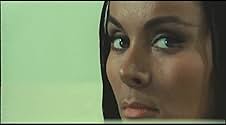AVALIAÇÃO DA IMDb
6,7/10
8,3 mil
SUA AVALIAÇÃO
Um diretor de Hollywood emerge do exílio com planos para completar um filme inovador.Um diretor de Hollywood emerge do exílio com planos para completar um filme inovador.Um diretor de Hollywood emerge do exílio com planos para completar um filme inovador.
- Prêmios
- 9 vitórias e 8 indicações no total
Robert Random
- John Dale
- (as Bob Random)
- Direção
- Roteiristas
- Elenco e equipe completos
- Produção, bilheteria e muito mais no IMDbPro
Avaliações em destaque
I had the privilege of seeing this at the New York Film Festival. A sense of awe descended upon the audience as soon as the opening credits began. The fact that this film was finally completed and released is a triumph in and of itself.
Orson Welles' final film is chaotic and unwieldy, but also very haunting and melancholy. The soundtrack is amazing. There is frankly a sliver of a plot. An aging director attempts to make a comeback as Hollywood has drifted away from his era as he throws a big birthday party in which journalists, critics, admirers and some industry professionals join to celebrate. It soon becomes apparent that reporters are there to ascertain information about more than his work. His new film that is in the works is shown. We get to see an unfinished film within a film that is titled "The Other Side of the Wind", one that is sexually explicit.
The late John Huston portrays Jake Hannaford, the director whose approach to filmmaking has earned him a great following and his relationships with the actors he works with makes him a lightning rod of controversy. Huston's sepulchral voice and domineering presence make him flawless in the role as Hannaford. Peter Bogdanovich is well utilized as a younger, successful director whom Hannaford has taken under his wing but whom now Hannaford consults on how to better reach audiences of the new era.
This film is not flawless. The experience of seeing this at long last outweighs its drawbacks. There are some parts of this film that drag a bit. But there are also many, many scenes that are just astounding and I'm so happy they were finally brought to the big screen. Although this film is inconsistent in its narrative thrust, it returns very quickly to its busy, slightly manic state. I don't know if Welles deliberately left this unfinished. What I can say is that the editing is superb and provides us with a film that is a lasting testament to Welles and his legacy as a filmmaker. Highly recommended.
Orson Welles' final film is chaotic and unwieldy, but also very haunting and melancholy. The soundtrack is amazing. There is frankly a sliver of a plot. An aging director attempts to make a comeback as Hollywood has drifted away from his era as he throws a big birthday party in which journalists, critics, admirers and some industry professionals join to celebrate. It soon becomes apparent that reporters are there to ascertain information about more than his work. His new film that is in the works is shown. We get to see an unfinished film within a film that is titled "The Other Side of the Wind", one that is sexually explicit.
The late John Huston portrays Jake Hannaford, the director whose approach to filmmaking has earned him a great following and his relationships with the actors he works with makes him a lightning rod of controversy. Huston's sepulchral voice and domineering presence make him flawless in the role as Hannaford. Peter Bogdanovich is well utilized as a younger, successful director whom Hannaford has taken under his wing but whom now Hannaford consults on how to better reach audiences of the new era.
This film is not flawless. The experience of seeing this at long last outweighs its drawbacks. There are some parts of this film that drag a bit. But there are also many, many scenes that are just astounding and I'm so happy they were finally brought to the big screen. Although this film is inconsistent in its narrative thrust, it returns very quickly to its busy, slightly manic state. I don't know if Welles deliberately left this unfinished. What I can say is that the editing is superb and provides us with a film that is a lasting testament to Welles and his legacy as a filmmaker. Highly recommended.
Other reviews have shed light on the challenges and controversy surrounding the creation of this film, so I will not cover that. The initial scenes are haphazard, but after a short while, the plot adopts a firmer grasp. Some scenes were shot in b/w, and other in color, and the mix of the various film stocks does work, for the most part. Shrewd, biting humor infuse the entire film, which skewers the Hollywood studio system and offers glimpses of hangers-on, while highlighting the sordid nature of fame.
Wonderful cast, with standout performances from Huston and Foster. Some of the the dialogue appeared improvised, and the energy was highly-charged. The upbeat jazz score by Michel Legrand was terrific. Overall, I enjoyed this wild ride. Even so, I wonder what would have happened if Welles would have had the funds to personally helm this film into full fruition? Did he genuinely intend for this film to be finished by someone else? What would have happened if it had been retained as a lengthy, experimental journey?
Wonderful cast, with standout performances from Huston and Foster. Some of the the dialogue appeared improvised, and the energy was highly-charged. The upbeat jazz score by Michel Legrand was terrific. Overall, I enjoyed this wild ride. Even so, I wonder what would have happened if Welles would have had the funds to personally helm this film into full fruition? Did he genuinely intend for this film to be finished by someone else? What would have happened if it had been retained as a lengthy, experimental journey?
The Other Side of the Wind is not a perfect film, but perhaps the perfect film to punctuate Orson Welles' incredible and monolithic career, and certainly the most appropriate film to leave unfinished due to difficulty in production. Or perhaps it is the genius of Welles to have left the film unfinished on purpose?
The film focuses on "the man, the myth, the legend" type J.J. Hannaford, who is making his comeback film after a long hiatus of being out of touch with the modern movie realm. He celebrates his birthday by having a documentary team, friends, associates, and others join him for a showing of his new film "The Other Side of the Wind" starring his striking new lead actor Johnny Dale and lead actress (who is nameless according to the bill). What ensues is a chaotic, fast-paced bombardment of quick edits, snappy dialog, a movin' sound track, and fantastic camera-work sandwiched between the hypnotic, near-legato, orchestral moments of Hannaford's film "The Other Side of the Wind".
It took me about 25 min to get used to the faced-paced, almost bravado tone of the editing because I wanted more time to saturate the emotions and facial expressions of the characters. This is why I think the sections that show Hannaford's film stick out even more though; finally having time to "breath" (if you will) versus the zaniness of being in the business (reality). It even feels at times that Hannaford himself is drowning and just wants to breath. Even still, does Welles conduct an amazing performance from the grizzled-veteran John Huston, who nails the semi-pretentious over-indulgent Hannaford to a tee.
The highlights of Welles' last picture surely come from the technical aspects of the production, the anticipation born from it's long-troubled existence of coming to fruition, and the lead performance from Huston. I must say there are a handful of poignant, enigmatic scenes that truly hypnotize such as "The Other Side of the Wind"s rather incredible car scene, which for me was the true top moment of this feature. The camerawork changing from black and white to deep color is used to great effect as well.
I suppose we will never know if what we have today is truly Welles' vision fully intact, or just a shadow of what is was supposed to be. The Other Side of the Wind is definitely for any fans of Orson Welles and for those who enjoy seeing filmmaking done years ahead of its time. I feel like I must say that this film isn't getting praise from me simply because Welles' name is slapped on it, but good because there are a bunch of things to appreciate.
The film focuses on "the man, the myth, the legend" type J.J. Hannaford, who is making his comeback film after a long hiatus of being out of touch with the modern movie realm. He celebrates his birthday by having a documentary team, friends, associates, and others join him for a showing of his new film "The Other Side of the Wind" starring his striking new lead actor Johnny Dale and lead actress (who is nameless according to the bill). What ensues is a chaotic, fast-paced bombardment of quick edits, snappy dialog, a movin' sound track, and fantastic camera-work sandwiched between the hypnotic, near-legato, orchestral moments of Hannaford's film "The Other Side of the Wind".
It took me about 25 min to get used to the faced-paced, almost bravado tone of the editing because I wanted more time to saturate the emotions and facial expressions of the characters. This is why I think the sections that show Hannaford's film stick out even more though; finally having time to "breath" (if you will) versus the zaniness of being in the business (reality). It even feels at times that Hannaford himself is drowning and just wants to breath. Even still, does Welles conduct an amazing performance from the grizzled-veteran John Huston, who nails the semi-pretentious over-indulgent Hannaford to a tee.
The highlights of Welles' last picture surely come from the technical aspects of the production, the anticipation born from it's long-troubled existence of coming to fruition, and the lead performance from Huston. I must say there are a handful of poignant, enigmatic scenes that truly hypnotize such as "The Other Side of the Wind"s rather incredible car scene, which for me was the true top moment of this feature. The camerawork changing from black and white to deep color is used to great effect as well.
I suppose we will never know if what we have today is truly Welles' vision fully intact, or just a shadow of what is was supposed to be. The Other Side of the Wind is definitely for any fans of Orson Welles and for those who enjoy seeing filmmaking done years ahead of its time. I feel like I must say that this film isn't getting praise from me simply because Welles' name is slapped on it, but good because there are a bunch of things to appreciate.
Some films are hard to judge, especially something like this, that may be very close to what Welles intended, but never finished and never really seemed to be really satisfied with (see also the documentary about Welles from 2018, which is really good). Now there are things in here that may seem redundant to some or annoying. Or even pretentious to some extend. If that rings true to you or not, it doesn't mean you are right or wrong, one way or the other. It just means you have feeling and maybe knowledge and that's why you lean to a particular way or side.
Having written all that, I am surprised by the amount of nudity that made it into the film. I'm also surprised about the film depicting scenes being shot "in real time" with off commentaries by the director, with different cameras, cuts and all that. Now obviously we are taking creative liberties here and it's supposed to be heightened. It's to prove a point or even points. So in a way there is more to the film than meets the eye. You have to approach this movie with a certain mindset.
If you do that, you may be able to see more than some others. But if you don't you'll probably be bored. Whatever your stance on this is and it will be dividing, you cannot call this an easy movie to watch. Some probably will watch it multiple times and cherish it's commentary and behind the scenes insights as much as its psychology. Others will just sneer at the mention of the title. In a way I'd say that would make Welles happy after all ...
Having written all that, I am surprised by the amount of nudity that made it into the film. I'm also surprised about the film depicting scenes being shot "in real time" with off commentaries by the director, with different cameras, cuts and all that. Now obviously we are taking creative liberties here and it's supposed to be heightened. It's to prove a point or even points. So in a way there is more to the film than meets the eye. You have to approach this movie with a certain mindset.
If you do that, you may be able to see more than some others. But if you don't you'll probably be bored. Whatever your stance on this is and it will be dividing, you cannot call this an easy movie to watch. Some probably will watch it multiple times and cherish it's commentary and behind the scenes insights as much as its psychology. Others will just sneer at the mention of the title. In a way I'd say that would make Welles happy after all ...
So I reckon this film is sorta Orson Welles' version of Fellini's '8 1/2', a self-portrait, aiming at tearing down the facade in front of the man in favor of a multi-faceted, multi-personal panopticum, which might just be another facade.
In comparison to Fellinis movie, 'The Other Side of the Wind' is equally carnvalesque, more deconstructivist - individual roles seem to disolve or fade into each other in the more - more prone to abandon narrative structure, less cheerful, but ultimately more bitter. Whereas Fellini -- through Mastroianni -- seems to comment his own shortfalls as an artist and his faustian, sexual desire with a mischievous, but upbeat wink in the end, the narrator's final epigramm as well as the title of Welles' last movie seems to suggest a more macbethian philosophy: it was all a story full of sound and fury, signifying nothing, and the acclaimed director is nothing but the other side of the wind, blowing in a conversation.
In comparison to Fellinis movie, 'The Other Side of the Wind' is equally carnvalesque, more deconstructivist - individual roles seem to disolve or fade into each other in the more - more prone to abandon narrative structure, less cheerful, but ultimately more bitter. Whereas Fellini -- through Mastroianni -- seems to comment his own shortfalls as an artist and his faustian, sexual desire with a mischievous, but upbeat wink in the end, the narrator's final epigramm as well as the title of Welles' last movie seems to suggest a more macbethian philosophy: it was all a story full of sound and fury, signifying nothing, and the acclaimed director is nothing but the other side of the wind, blowing in a conversation.
Você sabia?
- CuriosidadesThe movie was filmed between 1970 and 1976, with editing continuing into the 1980s. When he died in October 1985, Welles left behind nearly 100 hours of footage and a work print consisting of assemblies and a few edited scenes.
- Erros de gravaçãoIn one confrontational scene, Brooks Otterlake, who Gregory Sierra's character, Jack Simon, refers to as, "Kid", is simultaneously Peter Bogdanovich and Rich Little. This is small overlap is because Rich Little was originally cast as the black turtleneck wearing, voice imitating director, Brooks Otterlake. However Bogdanovich replaced him, and Little's part was reduced to that of a Party Guest.
- Citações
[last lines]
Jake Hannaford: Who knows, maybe you can stare too hard at something, huh? Drain out the virtue, suck out the living juice. You shoot the great places and the pretty people... All those girls and boys. Shoot 'em dead.
- Cenas durante ou pós-créditosAfter the end credits, Hannaford's voice is heard saying "Cut"
- ConexõesFeatured in AFI Life Achievement Award: A Tribute to Orson Welles (1975)
- Trilhas sonorasLes Délinquants
Written and performed by Michel Legrand
Published by WB Music Corp. o/b/o Productions,
Michel Legrand + Editions Royalty
Courtesy of Decca Records France
Under license from Universal Music Enterprises
Principais escolhas
Faça login para avaliar e ver a lista de recomendações personalizadas
- How long is The Other Side of the Wind?Fornecido pela Alexa
Detalhes
- Data de lançamento
- Países de origem
- Central de atendimento oficial
- Idiomas
- Também conhecido como
- The Other Side of the Wind
- Locações de filme
- Empresas de produção
- Consulte mais créditos da empresa na IMDbPro
- Tempo de duração2 horas 2 minutos
- Cor
- Mixagem de som
Contribua para esta página
Sugerir uma alteração ou adicionar conteúdo ausente

Principal brecha
By what name was O Outro Lado do Vento (2018) officially released in India in English?
Responda




































